They went for a group photo. They stayed for the arrests.
When Capitol police blocked off the plaza to prevent a peaceful gathering from taking a group photo, several veterans rushed past the barriers.

On the eve of military parade that is either intended to celebrate the Army’s 250th anniversary—or the birthday of an insecure President, or a precursor to more grand dictatorial overtures, or some combination thereof—an assembly approximately 75 strong gathered in front of the Supreme Court with a pointed message of opposition: US forces have no business being used to do the President’s bidding.
American troops shouldn’t be on our streets to appease a Commander-in-Chief’s overzealous lust to eliminate targeted demographic groups from the country. That seems to have been the primary thesis for the group that gathered in front of the Supreme Court on Friday evening. After a few speakers, the otherwise mundane assembly was ready to disperse for the evening. The final touch: a group shot in front of (technically, behind) the Capitol building.
Enthusiasm for the group shot was not initially high. “Let’s go get this picture over with,” I heard one attendee say to others, while walking across the street. It wasn’t entirely clear, but my sense was that this group shot may not have been originally planned. And it didn’t seem to have been expected by many.
Shortly before the group had assembled, the plaza before the Capitol had been open to foot traffic, as normal. When Capitol Police heard the group was coming, they began erecting bicycle racks to block off the plaza. Photography is a well known high risk activity.
This suppression of first amendment rights did not go over well. As the group began assembling in front of the bike racks, at approximately 6:50 pm, a few complained to a police officer. After what seemed to be a response in the general vicinity of “tough luck” an attendee casually moved one of the bike racks aside, and stepped forward. After a stern word from the police officer, a second person moved a second bike rack aside and stepped forward. A moment later, dozens of people were moving toward the Capitol. Some ran, others walked. A few gimped with their mobility devices.
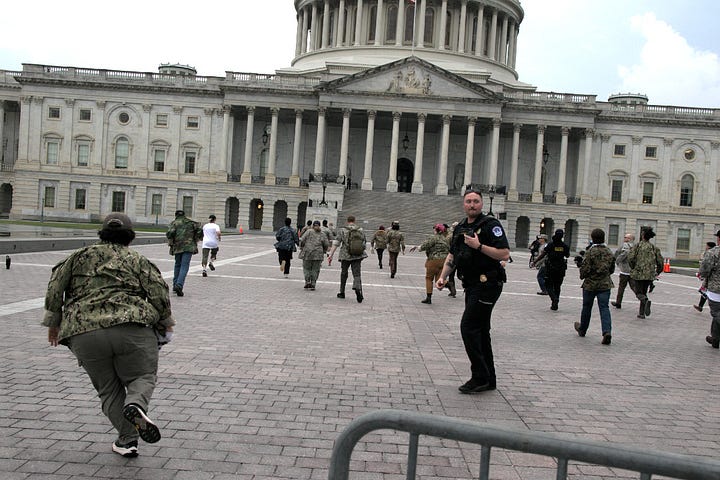

As they reached the Capitol steps most promptly sat down in front of the bike rack barrier that is always in place atop the first flight of stairs. A couple decided to press forward and attempt to ascend toward the entrance, though I don’t really understand why. They were promptly thrown back over the bike racks. A few more moments later, and a full assortment of protesters was settled onto the steps, displaying their signs and banners. I could hear cheers behind me from the main body of the assembly, applauding their tenacity.
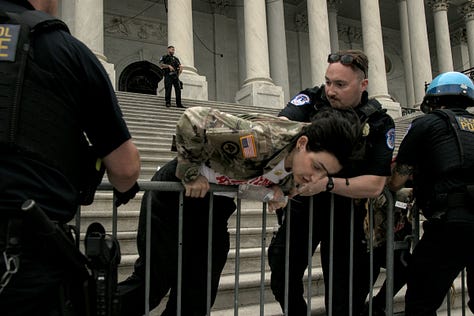
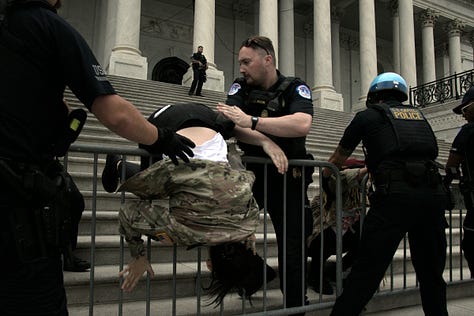
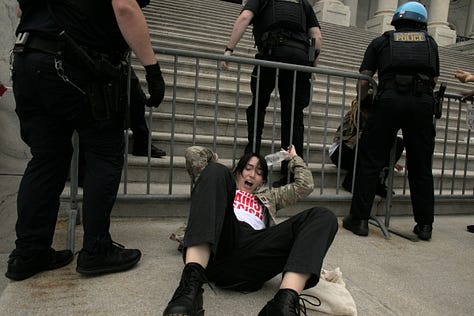
One of the protesters stood up to defend the barrier of the bike rack, urging his compatriots to let this be far enough. A second attempted to break the fall of one of the protesters who was being thrown back over the bike racks by police. The police promptly restrained her. She sat back down again, but a few moments later police ordered her removal from the bunch and placed under arrest. She surrendered herself without resistance.
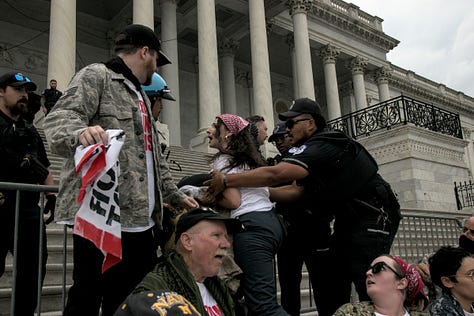
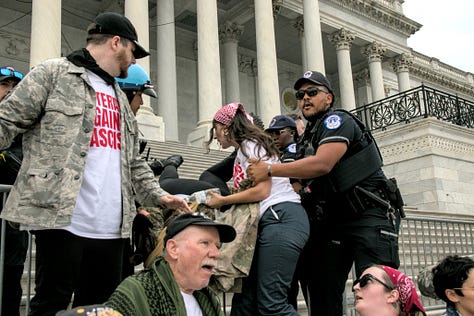
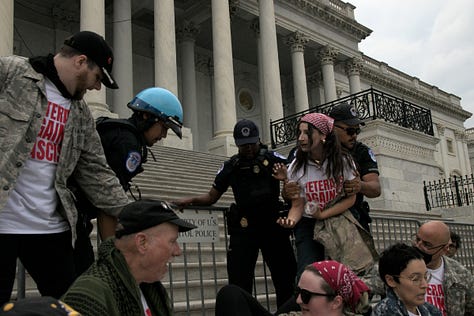
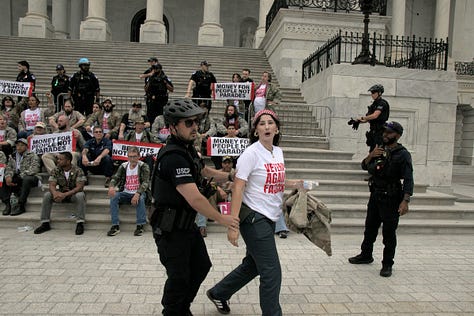
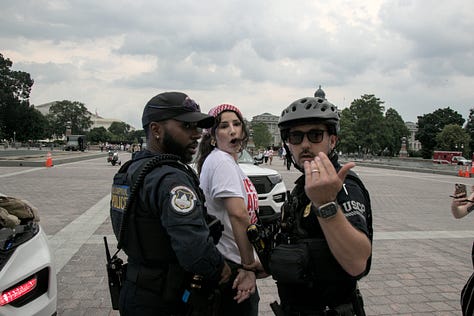
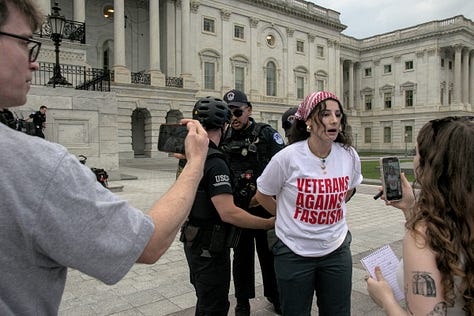
The protesters that were left were not going to be far behind her. A few officers began handing out flexicuffs to the rest who were on hand. Unfazed, the protesters on the steps remained in place with their signs and banners, now more determined than ever to not be silenced. The main group continued to voice their encouragement, which soon led to call-and-response chants between the sit-ins and the main group.
What began as a simple plan to voice themselves with a group photograph in front of the Capitol had now become a foxhole for free speech itself. The protesters decried the expense of a military parade while veteran benefits continued to be underfunded, and condemned gratifying President Trump’s ego in their name. Returning to the main group I heard people wonder why the plaza was suddenly off limits. Journalists on hand compared observations, generally confirming that the plaza had only now been deemed closed.

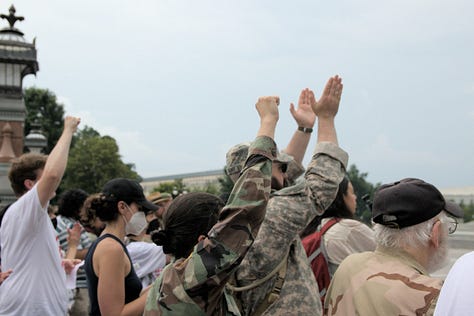

One man declared that the police prohibiting the group’s entrance onto the plaza had gone on long enough, and needed to end. An octogenarian with a walker, he made an opening in the line of bike racks, entering the plaza. He approached a police officer, trying to make his case. A second officer joined. It was clear from everyone’s body language the sides were at an impasse.
When another protester called out to the man (addressing him by the name John) asking if he wanted to come back, John replied “No, I want to go over there ‘cause that’s where they are.”
“Then don’t take ‘no’ for an answer.”
With that, John spun around to outflank the officers, making his move. But he wasn’t going to be fast enough. The two officers promptly interceded, declaring John under arrest. His hands were placed behind his back and confined with flexicuffs.
The crowd initially cheered John’s refusal to be silenced. But they especially objected to how police were responding to John. Shouts of “Shame!” were quickly followed by chants demanding officers “put his hands in front of him!” One of the officers then walked John away, while the second officer stayed behind with John’s walker.
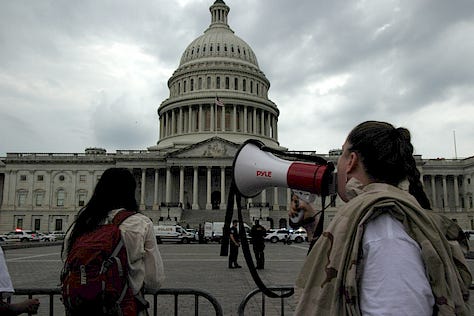
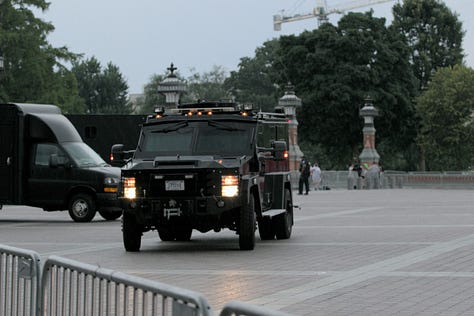

After a few more minutes a tactical vehicle made an entrance onto the plaza, as rain began to fall. This was followed with busses onto which arrested individuals would be loaded. Umbrellas opened and chants continued. Nobody was leaving yet. Some time passed and a bus was loaded. Some time longer, a second bus was loaded. It was approximately 8:00 pm before the arrested protesters were finally driven away, with thunder rolling through the sky.
With the the buses gone an officer approached the main group, asking if there was someone in charge. A woman with brown hair stepped forward and heard the officer’s request for the crowd to disperse, noting the incoming lightning storm as a danger to their safety. Agreeing with the officer, she took possession of a bullhorn to thank the attendees for their participation, and declaring the action to be at its conclusion.


